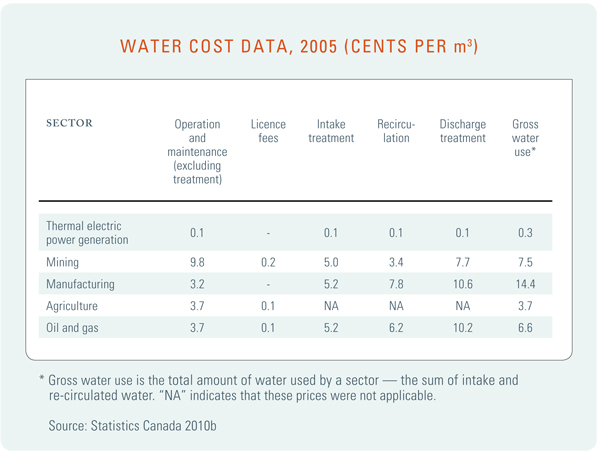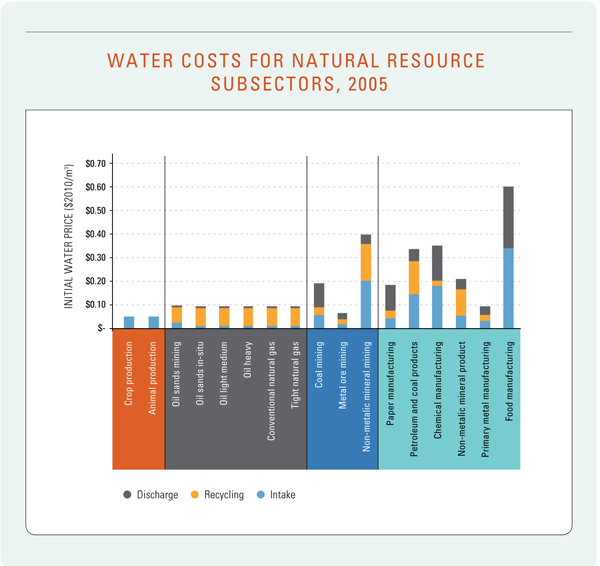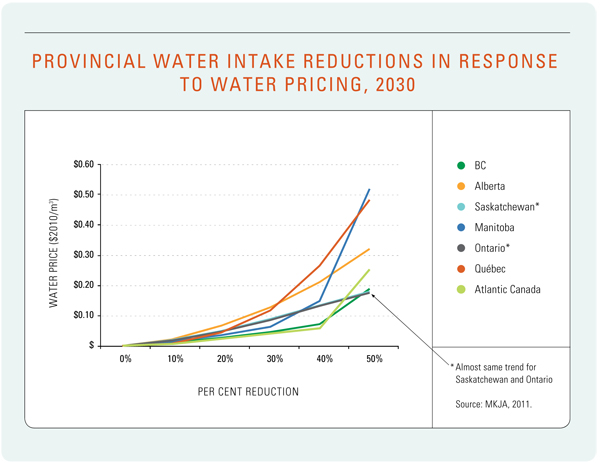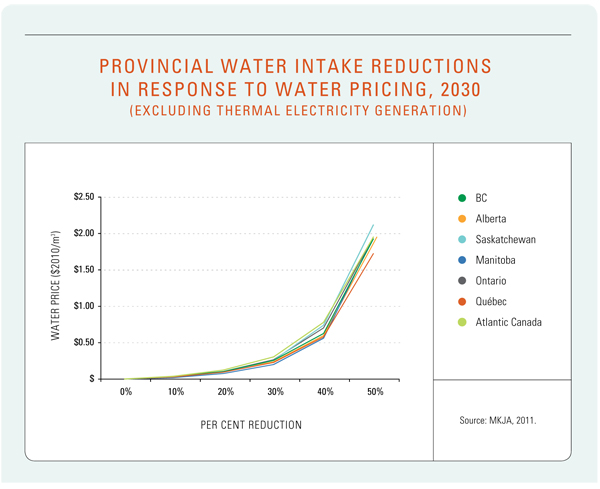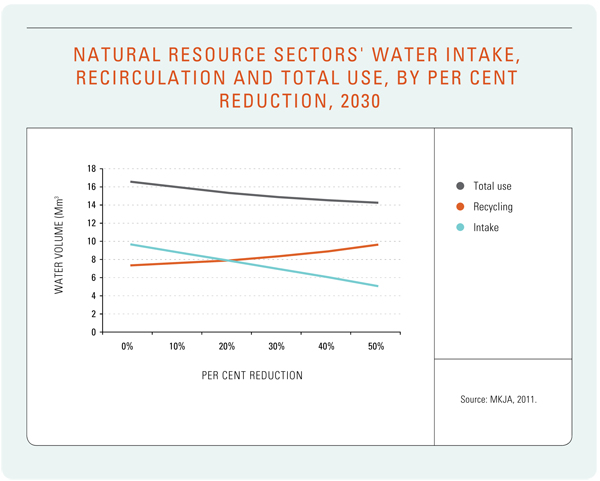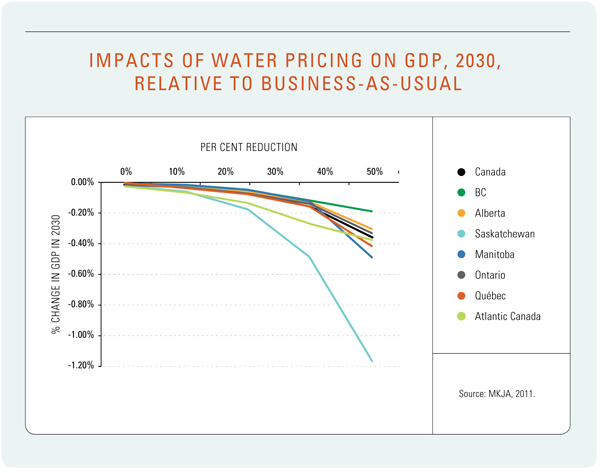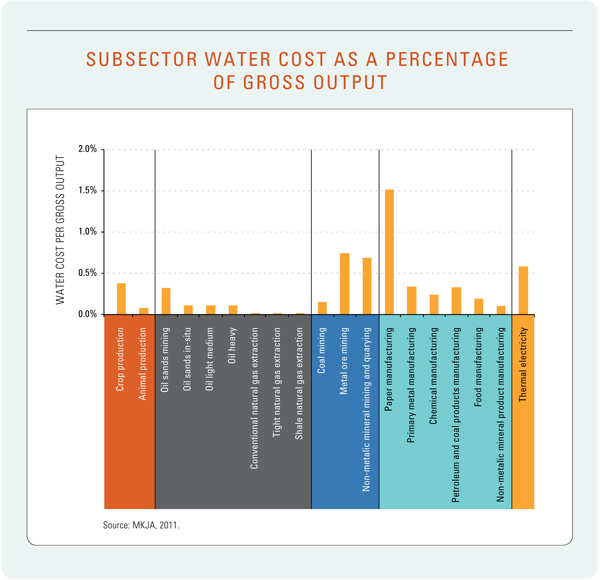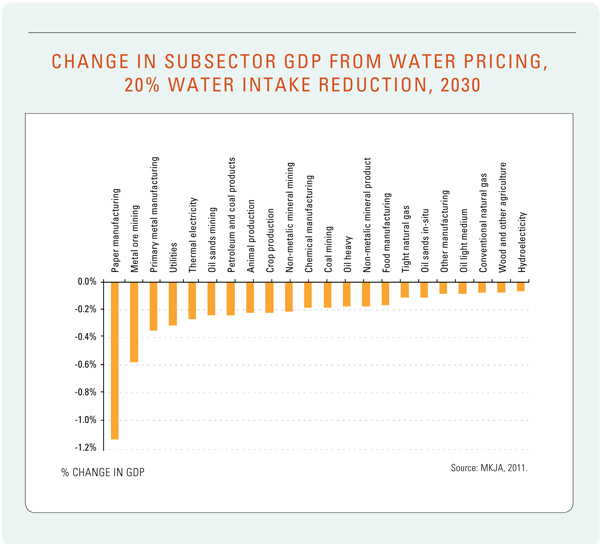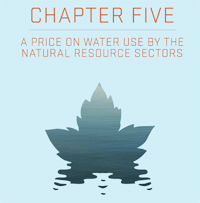Charting a Course – Pricing Water
In researching various policy tools, the NRTEE identified a lack of information on water pricing in Canada, specifically on the potential for volumetric water pricing. We therefore conducted new and innovative research to determine the potential of water pricing to deliver on our two goals of improved water efficiency and improved water conservation.
We find that water pricing applied to the intake of self-supplied water in the natural resource sector may deliver water-use reductions thorough efficiency and conservation gains at costs that may be minimal. Water prices afford a significant opportunity to reinforce water-efficiency gains. Of course, there will be cost impacts on industry, ranging from small to large depending on the sector. But for all sectors, costs rise quickly as greater water-use reductions are sought.
The Current Price of Water
A key starting point for assessing the potential of water pricing is to determine the costs that industry currently pays for water intake and use. Outside of industry there is a perception that water is free. In reality, the use of water has costs associated with it, which vary across the country and between sectors. The total cost of using water includes components of what is paid in licensing fees to provincial governments as well as intake, recirculation, and discharge costs that require energy, labour, and capital.
This data highlights that industry does indeed pay to use water: it is not a free commodity. While water-licensing fees account for less than 1% of the total cost, water use represents a real operational cost to industry.
The Potential of Water Pricing to Improve Efficiency and Conservation
The NRTEE used a macroeconomic model of the Canadian economy to assess the potential of water pricing to improve water-use efficiency and conservation and to estimate the impact of the pricing on industry. Overall, the reduction in gross water use with water pricing translates into an increase in the efficiency of gross water use by 8% with an increase in water price of $0.09 per m3 and 14% with an increase of $0.55 per m3. This means that conservation contributes an important part of the fall in total intake. A key finding is that industry is responsive to the price of water, and efficiency and conservation gains can be expected with small increases in the price of water.
Economic Impacts
A first area of focus is on how gross domestic product (GDP) is affected by water pricing. Overall, economic impacts on Canada resulting from even substantial increases in water prices are likely to be very small. The model suggests a 0.03% reduction in the level (not to be confused with the growth rate) of GDP in 2030 associated with a 20% reduction in water intake in each of the provinces; and a 0.16% reduction in the level of GDP associated with a 40% reduction in water intake. This means that even with the 40% water intake reduction, the economy will continue to grow, and will still be approximately one and a half times larger in 2030. The economic effects of modest increases in the price paid for water appear to be small, affording an opportunity for water users to compensate Canadians for the use of this public resource.
The second area we investigated was the potential impact that pricing would have on the natural resource sectors. While the natural gas sectors have the lowest cost per unit of gross output, the cost of water to most sectors is less than 0.5% of their overall gross output. In comparison, the sectors included in this study will pay 15% of their output for energy and 44% for other intermediate inputs. The cost of water makes up more than 0.5% in just four sectors: paper manufacturing (1.9%), metal ore mining (0.9%), non-metallic mineral mining (0.9%), and thermal electric power generation (0.7%). This indicates a risk that water pricing could lead to adverse competitiveness impacts for some, but not all, sectors.
Summary
Our research reveals that the natural resource sectors currently do pay for water use, largely through costs associated with water infrastructure (treatment, movement, and discharge). Our findings show the potential effects of pricing water on achievement of environmental water reduction objectives, with perhaps minimal economic impacts to most sectors and the national economy. A price on water reduces intake by industry resulting in more conservation and better water-use efficiency.
Some industries may be responsive to the price of water, and large efficiency and conservation gains may be achieved with modest increases in the price of water intake. Water recirculation currently plays an important role in water use by many of the industrial sectors, and it appears that water recirculation may have a significant role in future water reductions, as a price on water pushes industries to find innovative ways of using recycled water.
Recommendations
- Governments should research the relationship between water use and pricing needs before they implement water pricing on a volumetric basis. Specifically, they need to better understand the potential implications on sectors and firms. In order to do so, data on water use needs to improve, to gain a better understanding of water intakes, recirculation, and recycling within facilities.
- The natural resource sectors should look closely at their water intake and where the costs rest within their use of water. Incorporating the “value” of water into operations may reveal opportunities for costs savings, through implementation of improved technologies or best management practices, possibly leading to overall water intake reductions.
- If a price is put on water use by the natural resource sectors, revenues should be directed to support watershed-based governance and management initiatives, rather than put into general revenue of the province or territory.
Read the Report
CHAPTER 5: A PRICE ON WATER USE BY THE NATURAL RESOURCE SECTORS (HTML)
DOWNLOAD THE FULL REPORT (PDF version)

























